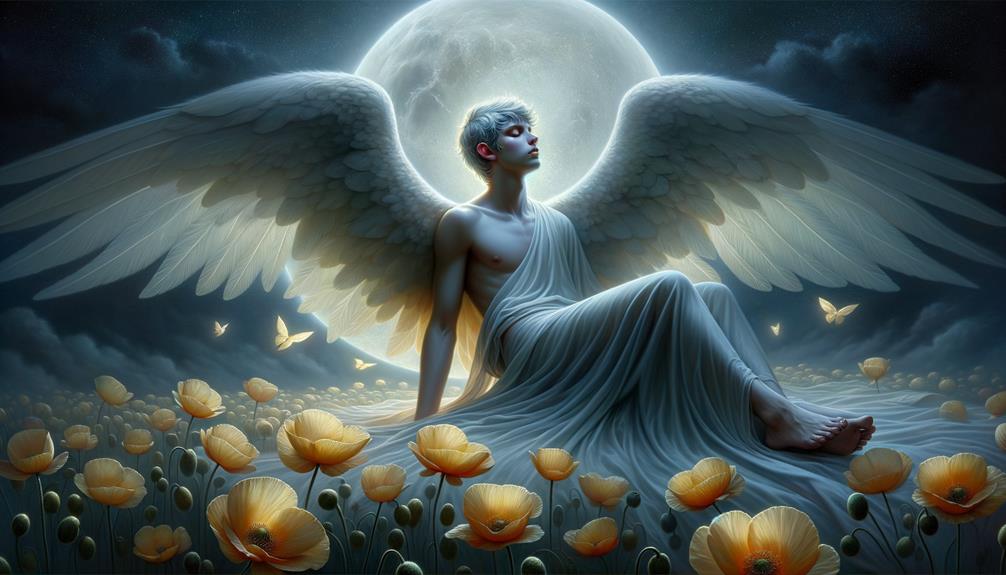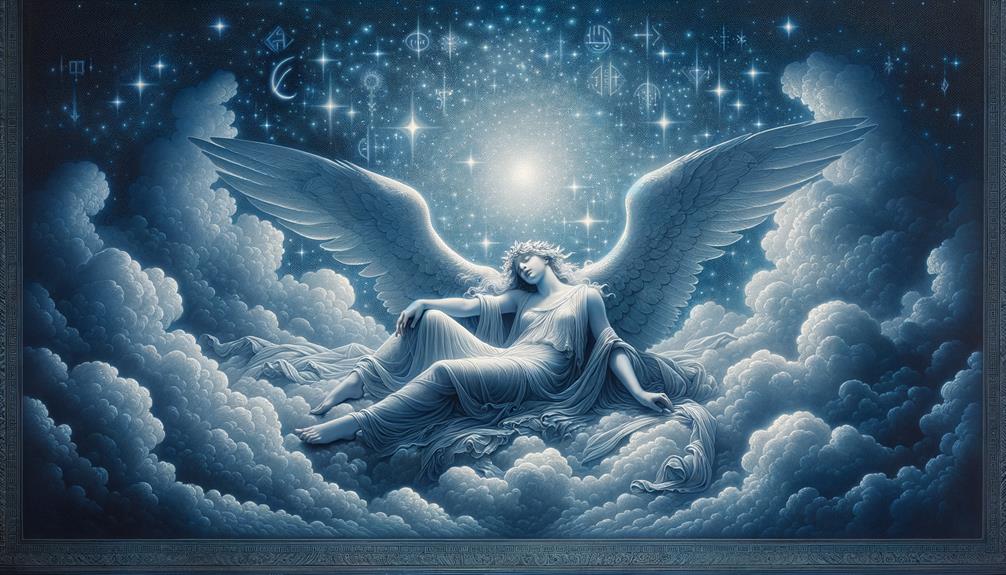I wander into the twilight realm to encounter Hypnos, the Greek deity of slumber. Born to Nyx, night's embodiment, and Erebus, the essence of darkness, Hypnos commands the ability to lull gods and mortals alike into restful sleep. His twin, Thanatos, personifies death, revealing the delicate veil separating sleep from the eternal unknown. Hypnos bestowed sleep upon Zeus himself, altering the Trojan War's course. By the river Lethe, he symbolizes tranquility and forgetfulness. His offspring, the Oneiroi, guide our dreams. Envision Hypnos visiting Endymion, granting him eternal youth through unending slumber. Journey onward to unravel the secrets and mysteries woven into the realm of dreams and serenity.
Family of Hypnos
In Greek myths, Hypnos represented sleep – the son of Nyx, goddess of night, and Erebus, the embodiment of darkness. His twin Thanatos embodied death, making sleep and death two sides of one coin.
Nyx bestowed Hypnos the ability to grant rest to the weary. Erebus's impenetrable darkness added depth to Hypnos's realm where dreams and reality intertwined. Hypnos's offspring, the Oneiroi dream gods Morpheus, Ikelos, and Phantasos, inherited fragments of his power, guiding mortals through dreamscapes.
In these stories, Hypnos's family ties highlighted his vital role in the life-death cycle, ensuring gods and humans alike found refuge in sleep's embrace. The myths underscore sleep's importance through the bonds uniting Hypnos to night, darkness, dreams, and the enigma of death itself.
Role in Mythology

Hypnos, the Greek god of sleep, played a pivotal role in mythology, guiding gods and mortals into the dream realm. His presence lingered in the night, as he drifted near the river Lethe, symbolizing forgetfulness and dreams' elusiveness.
One of Hypnos's notable acts involved lulling Zeus to sleep during the Trojan War at Hera's request, altering the conflict's course. This showcased his ability to influence even the mightiest deities. Mortals, too, succumbed to his touch, finding respite and visions in slumber's embrace.
Ancient artwork frequently depicted Hypnos surrounded by his sons, each representing different dreams bestowed upon humanity. These visuals highlighted his importance in the pantheon, emphasizing the nightly journey from consciousness to the enigmatic dreamscape. Hypnos embodied the delicate balance between wakefulness and rest, a timeless figure in Greek lore.
Hypnos and Endymion
Zeus commanded me, Hypnos, to cast Endymion into a deep, never-ending slumber, granting him eternal youth. Each night, under the moon's tender gaze, Selene's love for Endymion blossoms as they embrace. This tale intertwines the themes of everlasting rest and celestial romance, exemplifying my reign over dreams.
Eternal Sleep Blessing
Hypnos, the god of slumber, gifted Endymion, a humble shepherd, with an everlasting sleep. This divine blessing preserved Endymion's youth and striking looks for eternity, shielding him from the ravages of time. As he lay in peaceful repose, untouched by age or fatigue, his visage remained as captivating as the day Hypnos bestowed this gift upon him.
Endymion's eternal rest wasn't merely an absence of consciousness but a transcendence into a realm where earthly constraints held no power. Hypnos offered more than just an escape from weariness; he provided a sanctuary where beauty and serenity could thrive unimpeded by the burdens of wakefulness.
This myth symbolizes the power of Hypnos' gift. It celebrates the triumph of undying youth and tranquil beauty over life's struggles. Endymion's story exemplifies the hero's journey into a divine state of existence, where peaceful slumber reigns supreme. In this timeless harmony, Endymion found solace, forever cradled by Hypnos' whisper.
Divine Nightly Visits
Each night, the moon illuminated the earth. From the twilight realm, Hypnos, the god of Sleep and Death, visited Endymion, a shepherd in an unending slumber. This eternal sleep resulted from Selene's wish for her love with Endymion to endure forever.
During these nightly encounters, Hypnos brought serenity. The Endymion myth embodies the profound ties between affection, slumber, and divine intervention. Each visit highlighted Hypnos' role in balancing mortal and immortal realms.
Contemplate the emotional depth:
- Everlasting Love: Selene's timeless devotion for Endymion, preserved by Hypnos.
- Restful Slumber: Hypnos' ability to grant peaceful, untroubled sleep, even eternal rest.
- Divine Duty: Hypnos' nightly journey to sustain Endymion's sleep, fulfilling a celestial vow.
- Intertwined Destinies: The entwined fates of gods and mortals, displaying the delicate equilibrium of divine influence.
This myth showcases Hypnos' benevolent nature, his power to bestow rest, and his integral mythological role.
Depictions in Art

Hypnos, the ancient Greek deity of sleep, has long captivated artists' imaginations. Renaissance painters depicted serene scenes where the winged god bestowed restful slumber upon weary mortals. These symbolic artworks showcase Hypnos' persistent influence over both the human and divine realms.
In more casual terms, ancient Greek sculptors portrayed Hypnos as a chill dude with wings on his head, representing his power over dreamland. Renaissance artists took a similar approach, painting him helping tired people catch some Zs. These visuals highlight how Hypnos held sway over regular folks and gods alike.
Ancient Greek Sculptures
In the ancient world, Greek sculptors immortalized Hypnos as a composed and young deity. His divine essence flowed through wings adorning his temples or shoulders. These artistic renderings, often cast in bronze, conveyed his sacred duty overseeing sleep. The wings symbolized his ethereal nature, traversing the boundary between wakefulness and dreams.
The sculptures reveal a deeper narrative where Hypnos surrounds himself with poppies and opium plants. These elements metaphorically represent his dominion over sleep and dreams, offering rest and tranquility. Remarkable bronze heads of Hypnos discovered in places like Civitella d'Arno and Jumilla attest to his revered status in ancient Greek culture.
To artistically evoke Hypnos' essence, sculptors employed:
- Wings on temples: Depicting his divine ability to bring sleep.
- Youthful visage: Representing eternal peace and calm.
- Bronze medium: Reflecting the timeless nature of his influence.
- Poppies and opium plants: Emphasizing his connection to sleep and dreams.
Through these sculptures, Hypnos remains an enduring symbol of serenity and the divine power of rest.
Renaissance Artistic Interpretations
Renaissance artists like Sandro Botticelli and Albrecht Dürer incorporated the Greek god Hypnos, the personification of sleep, into their masterpieces. They captured his dreamy aura and dominion over the subconscious realm. In these artworks, Hypnos, son of Nyx (goddess of Night) and brother of Thanatos (personification of Death), appeared as an enigmatic figure. Symbolic imagery conveyed the world of dreams where Hypnos reigned.
Botticelli's brushstrokes brought Hypnos to life, often accompanied by his sons, the Oneiroi, dream-bringers representing different dream types. This enriched the depiction of Greek mythological archetypes. Dürer and Piero di Cosimo also featured Hypnos, exploring the interplay between sleep, dreams, and death in their Renaissance art.
The revival of interest in Greek mythology during the Renaissance thrust Hypnos into the spotlight, allowing artists to delve into the unconscious mind's mysteries. These works celebrated divine beings while inviting viewers to contemplate the unseen realms beyond wakefulness.
Cultural Influence

Hypnos, the Greek god of sleep, has left an indelible mark on our cultural landscape. As the sibling of Thanatos, the deity of violent death, Hypnos represents the delicate balance between life's daily grind and the eternal unknown, offering a nightly escape through dreams. In ancient Greece, near the babbling river Lethe, Hypnos reigned supreme with a serene presence reminiscent of lullabies sung by maidens.
Hypnos' influence permeates various facets of culture:
- Literature: Epic narratives like Ovid's Metamorphoses and Homer's Iliad feature Hypnos, shaping their stories.
- Language: The modern term "hypnosis" derives directly from his name, embedding him in our vocabulary.
- Visual Arts: Ancient Greek pottery, such as works by Euphronius, immortalize Hypnos' tranquil likeness.
- Psychology: Contemporary understandings of sleep and dreams draw inspiration from the mythology surrounding Hypnos.
More than just a deity, Hypnos symbolizes tranquility and respite. Through his gentle dominion, we gain deeper insights into the restorative power of rest, the magic of dreams, and the delicate thread connecting us to the divine.
Related Deities

In Greek mythology, Hypnos' role intertwines with various deities representing different aspects of the human experience. As Nyx's son, the primordial goddess of Night, and Thanatos' twin brother, the god of Death, Hypnos stands at the boundary between life and death. Ancient art often depicted Hypnos and Thanatos together, embodying the natural cycles of rest and finality.
Notably, Hypnos once put Zeus to sleep, aiding Hera's cunning plans during the Trojan War. This act allowed the Greeks to gain an advantage and nearly sack Troy, highlighting Hypnos' power to induce slumber even over mighty gods.
Hypnos is also linked to the river Lethe, symbolizing forgetfulness. As mortals drank from this river, they released their earthly memories, drifting into peaceful oblivion under Hypnos' gentle touch. His offspring, Morpheus, Icelus, and Phantasus, brought dreams of varying depths and shades, weaving a tapestry that showcased the profound interplay between sleep, dreams, and the human psyche.
Frequently Asked Questions
What Is the Myth of Hypnos?
As Hypnos, I represent sleep itself, born of the night, weaving tranquility and guiding mortals through dreamlands. I once lulled mighty Zeus into slumber, aiding his divine plans. My children, the Oneiroi, shape human visions, shepherding souls through realms of restful slumber.
Why Did Hypnos Put Zeus to Sleep?
Hera, the cunning queen, requested Hypnos put Zeus to sleep, granting her abilities to sway events during the Trojan War. Under Hypnos' slumberous influence, she manipulated fates and shifted tides through illusions.
What Are the Powers of Hypnos the God of Sleep?
I gently coax gods and mortals into peaceful slumber, weaving visions that soothe their spirits. My touch offers temporary escape from troubles. I guide souls across the river Lethe, allowing them to let go of memories and find serenity in oblivion for a while.
Is Hypnos or Morpheus the God of Sleep?
Hypnos undoubtedly reigns over tranquility, a master of slumber with unparalleled power. His son, Morpheus, sculpts our dreams, weaving tales that captivate our minds with wonder and mystery as we sleep.


